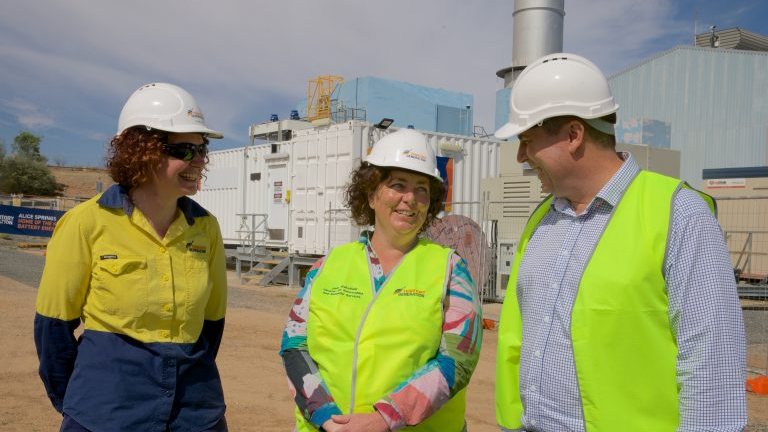
Image: Territory Generation
The 5MW Alice Springs Battery Energy Storage System (BESS) was officially launched on Friday, which will enable greater solar power penetration and improve grid stability.
Currently, solar energy can supply up anywhere up to 40% of Alice Springs’ electricity needs during the middle of the day. It has been estimated the battery system will support an increase up to 50%, as well as assisting in smoothing the output of solar power during cloud events.
Intermittent cloud has caused its share of issues in Alice Springs as a significant amount of capacity concentrated at the 4.1MW Uterne Solar Farm, which on its own can supply around 6% of Alice Springs’ peak demand on a sunny day.
The battery has already been exporting electricity to the grid during its testing phase and is expected to be fully integrated into Alice Springs’ electricity system by the end of this month.
The $8.3 million invested in the system should be recouped in four to five years as a result of efficiency improvements.
“We are investing in Alice Springs to achieve our renewable energy target and become the Solar Capital of Australia,” said Minister for Renewables and Essential Services Dale Wakefield, who launched the BESS. “The new Alice Springs Battery Energy Storage System is an important piece of infrastructure that will enable us to integrate more renewables, and provide increased reliability of supply to homes and businesses in Alice Springs.”
While a far larger battery system is across the border in SA, the Tesla Big Battery, the contribution Alice Springs’ BESS will make is considerable.
“The reality is that even though our solution is much smaller, it represents a greater percentage of the grid – ours is 10 per cent of the total load compared to about five per cent in SA,” said Territory Generation CEO Tim Duignan last year.
The tender for the project was awarded to Vector Energy and incorporates batteries from LG Chem. The BESS may be expanded in the time ahead.
The Northern Territory Government is keen to get runs on the board as it has committed to 50% renewables by 2030. The Roadmap to Renewables Report was delivered nearly a year ago, with solar power as the centerpiece energy technology.
While the NT Government appears to have been somewhat distracted this year while fracking around with gas, there’s been recent forward movement on renewables with the announcement last month the Gunner Government will form the Northern Territory Electricity Market (NTEM) to help ensure renewable energy projects are developed in a way to provide the best results.

 RSS - Posts
RSS - Posts



I believe that, in such reports, especially where comparisons between external jurisdictions are involved, inclusion of relative per capita quantities, would be appropriate.
For example, the comparison of the 5MW BESS for Alice Springs, to the 100MW (?) BESS for South Australia (and, I note that the power, but, not the retrievable energy capacity, is mentioned), would be clearer, if the respective relativities to the respective populations, would be included.
Foir example, if the Northern Territory has one twentieth as many residents, as South Australia, then the 5MW BESS would be proportionally, no less than the 100MW BESS of South Australia (assuming that the respective retrievable stored energy quantities per caipta, are sufficiently similar).
So, Ibelieve that inclusion of per capita qunatities, would be appropriate, in such reports (and, the applicable, per capita, quantitiesof retrievalble stored energy capacity – in kWh or MWh, as appropriate).
10% as against 5% I thought that explained it enough